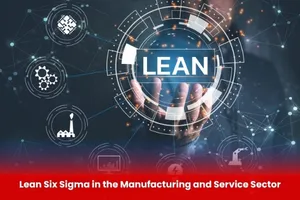Lean six sigma in the manufacturing and service sector
At Buraaq UK, we provide specialized Lean Six Sigma training designed to help professionals and organizations in both manufacturing and service industries improve efficiency and achieve operational excellence. Lean Six Sigma is a proven methodology that combines the principles of Lean (which focuses on eliminating waste) and Six Sigma (which aims at reducing defects and variability) to optimize business performance.

Aim of Lean six sigma in the manufacturing and service sector
The aim of Lean Six Sigma is to drive excellence by improving quality, reducing waste, and enhancing efficiency across manufacturing and service processes. It focuses on delivering consistent, high-quality products and services faster and at lower costs, while maximizing customer satisfaction.
Course Overview
Lean six sigma in the manufacturing and service sector
Educational Qualification
- Minimum: Intermediate (12th grade/A-level) for entry-level courses
- Preferred: Bachelor’s degree or equivalent in Engineering, Business, Management, or related fields for advanced courses (Green Belt, Black Belt)
Work Experience
- Fresh graduates can join basic/foundation-level courses
- Professionals working in manufacturing, production, quality control, operations, supply chain, or service industries are ideal candidates
- Experience is preferred but not mandatory for beginner courses
Skills & Language
- Basic computer skills (MS Office, especially Excel)
- Proficiency in English and/or Urdu to comprehend course material and communicate effectively
Other Requirements
- Willingness to learn and apply Lean Six Sigma concepts and tools
- Commitment to participate in workshops, assignments, and projects
| Course Code | Curriculum Title | Credit | DLH |
|---|---|---|---|
| BUK1672-1 | Understanding LEAN methodology concepts | 2 | 10 |
| BUK1672-2 | Learning the six sigma concepts and tools | 2 | 10 |
| BUK1672-3 | DMAIC process stages | 2 | 10 |
| BUK1672-4 | Finding and assessing the bottlenecks | 2 | 10 |
| BUK1672-5 | Mapping the customer value stream | 2 | 10 |
| BUK1672-6 | Grasping the 7 types of waste | 2 | 10 |
| BUK1672-7 | Normality, Stability, Capability Analyses | 2 | 10 |
| BUK1672-8 | Implementing LEAN tools to decrease process waste | 2 | 10 |
Learning Objectives
- Understanding LEAN methodology concepts
- Learning the six sigma concepts and tools
- DMAIC process stages
- Finding and assessing the bottlenecks
- Mapping the customer value stream
- Grasping the 7 types of waste
- The Define Phase
- The Measure Phase
- Define/Measure (Understanding the Current State)
- Project Definition, Project Charter
- Values Stream Mapping (VSM), Spaghetti Diagram
- Normality, Stability, Capability Analyses
- Analyze (Understanding Variation and Causal Factors)
- Analysis Plan & Hypothesis Testing
- T-Test, Chi-Square, Correlation, Regression, Equal Variances
- The Improve Phase
- Improve/Control (Generating Breakthrough Improvements)
- Mistake Proofing
- Kaizen
- Single Piece Flow
- Cost/Benefit Analysis
- Understanding key LEAN methods used for process improvement
- Implementing LEAN tools to decrease process waste
- Recognizing the elements of continuous improvement
- Bringing about measurable improvements in customer satisfaction,
- product quality and profitability
- Students & Graduates
- Working Professionals
- Supervisors & Managers
- Business Owners & Entrepreneurs
- All Modules within this qualification are assessed internally by the approved training Centre and externally verified by BURRAQ UK. The program uses a criterion-referenced assessment approach to ensure that learners successfully meet all required learning outcomes.
- A Pass in any unit is granted only when the learner submits valid, reliable, and authentic evidence that demonstrates achievement of the assessment criteria. The Assessor is responsible for reviewing this evidence and confirming that the learner has attained the expected standard.
